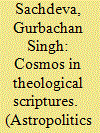|
|
|
Sort Order |
|
|
|
Items / Page
|
|
|
|
|
|
|
| Srl | Item |
| 1 |
ID:
116249


|
|
|
|
|
| Publication |
2012.
|
| Summary/Abstract |
Religions have conceptualized the cosmos, its Creator, and its origin. The major monotheistic religions of Judaism, Christianity, and Islam have philosophized on the creation of the Earth and man by a conscious act of God. The religions of the Orient-Hinduism and Sikhism-have a different visualization of the emergence of the universe and living beings on the Earth. This article provides a brief exposition and a comparative analysis of the scriptural differences in relation to the cosmos. In particular, the focus is on a comprehension expounded in Sikh scriptures with emphasis on the meaning therein for the Big Bang theory and exact time of creation, expanse of the universe, evolution of life, conservation of energy, and the end of the universe with cyclical repetition.
|
|
|
|
|
|
|
|
|
|
|
|
|
|
|
|
| 2 |
ID:
116246


|
|
|
|
|
| Publication |
2012.
|
| Summary/Abstract |
Social structural methods are applied to forecast the political economy of the inner solar system to the 22nd century. One method considers structural indicators, specifically, population, social organization, environment, and technology. Another method examines the Tongan diaspora as an analog of human expansion into space. This future political economy could emerge as a consequence of user strain on a global electrical power grid that develops by 2050. Alternative energy needs could turn to space-based sources. If on-orbit space-based energy infrastructure provides the rationale, capability, and allure to see humans routinely living and working in space, their presence on the Moon and among the near-Earth asteroids can lead to a human diaspora to Mars and its moons. These events will build the multi-planet economy, the multi-world system of societies, and the transnational state. The development of Mars will reach a maturity of settlement from 2130 onward. As these potential events become history, capital would be transformed, and higher-order space logistics in a multi-world system of societies with its multi-planet economy would lay the foundation for a Solar System Federation. This federation constitutes transnational states among off-world human societies that could fill the vacuum of a fading Westphalian nation-state system on Earth.
|
|
|
|
|
|
|
|
|
|
|
|
|
|
|
|
| 3 |
ID:
116247


|
|
|
|
|
| Publication |
2012.
|
| Summary/Abstract |
The mediums of space and the sea have many common characteristics. They are both common zones upon which armed forces cannot subsist. Due to their nature, these environments cannot be rendered into national possession. The inherent value of both mediums is to transmit communications. In particular, communications enabled by space-based assets are vital for digital societies. As such, these assets must be protected. However, using weapons to protect them is fraught with political peril. In this regard, it would be wise for spacepower strategists to consult the strategies of classical sea power theory to find important insights. There is a wealth of strategic knowledge to be considered here that would shed light on how to deal with threats in space, including the issue of orbital debris.
|
|
|
|
|
|
|
|
|
|
|
|
|
|
|
|
| 4 |
ID:
116248


|
|
|
|
|
| Publication |
2012.
|
| Summary/Abstract |
Space assets represent the most critical undefended resource of the United States. Though the government has clearly been aware of this weakness for over a generation, little appears to have been done about it. Every day these assets become more critical, and the threats against them are growing in kind. The United States must address these threats in order to prevent potential future issues in regard to military command and control, as well as the American way of life. This article not only outlines threats to space assets but proposes means by which U.S. space assets could be protected. Such protection comes not only from technology, which has been capable for years of doing the job, but from policy choice as well. In regard to policy, increasing research and development for space-based weapons, reevaluating existing treaties, and increasing interagency cooperation are all needed to better protect U.S. space assets.
|
|
|
|
|
|
|
|
|
|
|
|
|
|
|
|
|
|
|
|
|